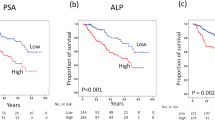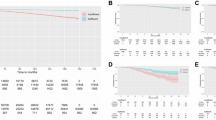Abstract
The specific aim of this analysis was to evaluate the capability of a time and prostate-specific antigen (PSA) threshold model to prognosticate overall survival (OS) and disease-specific survival (DSS) based on early PSA kinetics after radiotherapy for prostate cancer by retrospective review of outcomes in 918 patients. Crossing below analyzed PSA thresholds at specific defined time points reduced disease-specific death hazard ratios to relative to the cohort above threshold. The time and PSA threshold model demonstrates the ability to prognosticate OS and DSS as early as 3 months post-radiotherapy for prostate cancer.
This is a preview of subscription content, access via your institution
Access options
Subscribe to this journal
Receive 4 print issues and online access
$259.00 per year
only $64.75 per issue
Buy this article
- Purchase on Springer Link
- Instant access to full article PDF
Prices may be subject to local taxes which are calculated during checkout



Similar content being viewed by others
References
Carducci MA, DeWeese TL, Nelson JB . Prostate-specific antigen and other markers of therapeutic response. Urol Clin N Am 1999; 26: 291–302, viii.
Montie JE . Follow-up after radical prostatectomy or radiation therapy for prostate cancer. Urol Clin N Am 1994; 21: 673–676.
American Society for Therapeutic Radiology and Oncology Consensus Panel. Consensus statement: guidelines for PSA following radiation therapy. Int J Radiat Oncol Biol Phys 1997; 37: 1035–1041.
Small EJ, Roach III M . Prostate-specific antigen in prostate cancer: a case study in the development of a tumor marker to monitor recurrence and assess response. Semin Oncol 2002; 29: 264–273.
Taylor JM, Griffith KA, Sandler HM . Definitions of biochemical failure in prostate cancer following radiation therapy. Int J Radiat Oncol Biol Phys 2001; 50: 1212–1219.
Kattan MW, Fearn PA, Leibel S, Potters L . The definition of biochemical failure in patients treated with definitive radiotherapy. Int J Radiat Oncol Biol Phys 2000; 48: 1469–1474.
Hanlon AL, Hanks GE . Scrutiny of the ASTRO consensus definition of biochemical failure in irradiated prostate cancer patients demonstrates its usefulness and robustness. American Society for Therapeutic Radiology and Oncology. Int J Radiat Oncol Biol Phys 2000; 46: 559–566.
Lee WR, Hanlon AL, Hanks GE . Prostate specific antigen nadir following external beam radiation therapy for clinically localized prostate cancer: the relationship between nadir level and disease-free survival. J Urol 1996; 156 (Part 1): 450–453.
Thames H et al. Comparison of alternative biochemical failure definitions based on clinical outcome in 4839 prostate cancer patients treated by external beam radiotherapy between 1986 and 1995. Int J Radiat Oncol Biol Phys 2003; 57: 929–943.
D'Amico AV et al. Surrogate end point for prostate cancer-specific mortality after radical prostatectomy or radiation therapy. J Natl Cancer Inst 2003; 95: 1376–1383.
Cavanaugh SX et al. Early prostate-specific antigen (PSA) kinetics following prostate carcinoma radiotherapy: Prognostic value of a time-and-PSA threshold model. Cancer 2004; 101: 96–105.
Dawson NA . Response criteria in prostatic carcinoma. Semin Oncol 1999; 26: 174–184.
D'Amico AV et al. Determinants of prostate cancer specific survival following radiation therapy during the prostate specific antigen era. J Urol 2003; 170 (Part 2): S42–S46; discussion S46–S47.
Sandler HM, DeSilvio ML . Surrogate end points for prostate cancer: what is prostate-specific antigen telling us? J Natl Cancer Inst 2003; 95: 1352–1353.
Sartor O . Endpoints in prostate cancer clinical trials. Urology 2002; 60 (Suppl 1): 101–107; discussion 107–108.
Pollack A et al. Prostate biopsy status and PSA nadir level as early surrogates for treatment failure: analysis of a prostate cancer randomized radiation dose escalation trial. Int J Radiat Oncol Biol Phys 2002; 54: 677–685.
D'Amico AV et al. Utilizing predictions of early prostate-specific antigen failure to optimize patient selection for adjuvant systemic therapy trials. J Clin Oncol 2000; 18: 3240–3246.
Swindle PW, Kattan MW, Scardino PT . Markers and meaning of primary treatment failure. Urol Clin N Am 2003; 30: 377–401.
Kavadi VS, Zagars GK, Pollack A . Serum prostate-specific antigen after radiation therapy for clinically localized prostate cancer: prognostic implications. Int J Radiat Oncol Biol Phys 1994; 30: 279–287.
Critz FA et al. Prostate-specific antigen nadir of 0.5 ng/ml or less defines disease freedom for surgically staged men irradiated for prostate cancer. Urology 1997; 49: 668–672.
Bagshaw MA, Ray GR, Cox RS . Radiotherapy of prostatic carcinoma: long- or short-term efficacy (Stanford University experience). Urology 1985; 25 (Suppl): 17–23.
Prentice RL . Surrogate endpoints in clinical trials: definition and operational criteria. Stat Med 1989; 8: 431–440.
Buyse M, Molenberghs G . Criteria for the validation of surrogate endpoints in randomized experiments. Biometrics 1998; 54: 1014–1029.
Molenberghs G et al. Statistical challenges in the evaluation of surrogate endpoints in randomized trials. Control Clin Trials 2002; 23: 607–625.
Molenberghs G, Burzykowski T, Alonso A, Buyse M . A perspective on surrogate endpoints in controlled clinical trials. Stat Methods Med Res 2004; 13: 177–206.
Verbel DA, Heller G, Kelly WK, Scher HI . Quantifying the amount of variation in survival explained by prostate-specific antigen. Clin Cancer Res 2002; 8: 2576–2579.
Acknowledgements
Mr Fuller was supported by a grant from the NIH/NCRR/Frederic C Bartter GCRC-Mentored Medical Student Clinical Research Program (NIH M01-RR01346). Preliminary data from this work were presented at the meeting of the German Society for Radiation Oncology (DEGRO), in Erfurt, Germany, June 2004.
Author information
Authors and Affiliations
Corresponding author
Rights and permissions
About this article
Cite this article
Cavanaugh, S., Fuller, C., Kupelian, P. et al. Time and PSA threshold model prognosticates long-term overall and disease-specific survival in prostate cancer patients as early as 3 months after external beam radiation therapy. Prostate Cancer Prostatic Dis 8, 353–358 (2005). https://doi.org/10.1038/sj.pcan.4500831
Received:
Accepted:
Published:
Issue Date:
DOI: https://doi.org/10.1038/sj.pcan.4500831
Keywords
This article is cited by
-
Prostate-specific antigen nadir within 1 year of radiotherapy combined with hormone therapy predicts cancer-specific mortality and biochemical recurrence-free survival in prostate cancer patients
BMC Urology (2022)
-
Treatment outcome and compliance to dose-intensified linac-based SBRT for unfavorable prostate tumors using a novel real-time organ-motion tracking
Radiation Oncology (2021)
-
PSA nadir predicts long-term mortality
Nature Reviews Clinical Oncology (2010)



